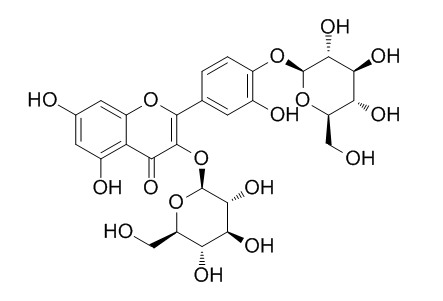Quercetin 3,4'-diglucoside
Quercetin 3,4'-diglucoside possesses antioxidant activities.
Inquire / Order:
manager@chemfaces.com
Technical Inquiries:
service@chemfaces.com
Tel:
+86-27-84237783
Fax:
+86-27-84254680
Address:
1 Building, No. 83, CheCheng Rd., Wuhan Economic and Technological Development Zone, Wuhan, Hubei 430056, PRC
Providing storage is as stated on the product vial and the vial is kept tightly sealed, the product can be stored for up to
24 months(2-8C).
Wherever possible, you should prepare and use solutions on the same day. However, if you need to make up stock solutions in advance, we recommend that you store the solution as aliquots in tightly sealed vials at -20C. Generally, these will be useable for up to two weeks. Before use, and prior to opening the vial we recommend that you allow your product to equilibrate to room temperature for at least 1 hour.
Need more advice on solubility, usage and handling? Please email to: service@chemfaces.com
The packaging of the product may have turned upside down during transportation, resulting in the natural compounds adhering to the neck or cap of the vial. take the vial out of its packaging and gently shake to let the compounds fall to the bottom of the vial. for liquid products, centrifuge at 200-500 RPM to gather the liquid at the bottom of the vial. try to avoid loss or contamination during handling.
Molecules.2021, 26(2):E255.
Life Sci.2023, 317:121458.
Chemical Engineering Journal2024, 500:157110
Int J Mol Sci.2021, 22(16):8641.
Food Hydrocolloids2024, 156:110345
Phytother Res.2019, 33(4):1104-1113
The Pharmaceutical Society of Japan2018, 138(4):571-579
J.Korean Society of Grassland&Forage Science2023, 43(3):138-147.
Biomed Sci Letters.2020, 26:319-326
Cell J.2024, 26(8):496-504.
Related and Featured Products
Food Research International, 2015, 67(jan.):349-355.
The microbial degradation of onion flavonol glucosides and their roasting products by the human gut bacteria Eubacterium ramulus and Flavonifractor plautii.[Reference:
WebLink]
Flavonoids are important constituents of the human diet. One source for flavonols, a major subclass of the flavonoids, is onion. It contains high amounts of quercetin glycosides, primarily quercetin 3,4′-di-O-glucoside (QDG) and quercetin-4′-O-monoglucoside (Q-4′-MG). Due to their high reactivity flavonols are susceptible to thermal degradation as used in food processing. Especially boiling and roasting influence the flavonoid content of food products. Quercetin and several of its glycosides may serve as substrates for human gut bacteria. For example, Eubacterium ramulus and Flavonifractor plautii are capable of cleaving the aglycone quercetin to form 3,4-dihydroxyphenylacetic acid (DHPAA) and phloroglucinol which to some extent can be degraded further. The aim of this study was to find out whether E. ramulus and F. plautii are also capable of degrading Q-4′-MG and QDG by and to investigate the influence of a thermal treatment (roasting) of the onion glucosides on the subsequent microbial degradation.
METHODS AND RESULTS:
In this study, E. ramulus was capable of degrading Q-4′-MG and QDG, while F. plautii was not. Roasting of QDG at 180 °C for 5 min led to the formation of quercetin with Q-4′-MG and quercetin-3-O-monoglucoside (Q-3-MG) as intermediates. Roasting accelerated the microbial degradation of Q-4′-MG and QDG. In the case of F. plautii, microbial degradation was induced by quercetin which was formed during roasting and is a preferred substrate of this organism.
Food Chemistry, 2017, 235(nov.15):119-126.
Utilization of quercetin and quercetin glycosides from onion (Allium cepa L.) solid waste as an antioxidant, urease and xanthine oxidase inhibitors.[Reference:
WebLink]
This study aimed to determine the flavonol glycosides from onion solid waste (OSW) using HPLC analysis, with antioxidant and enzyme inhibitory activities.
METHODS AND RESULTS:
We found considerable amount of quercetin-4'-O-monoglucoside (QMG: 254.85), quercetin-3,4'-O-diglucoside (Quercetin 3,4'-diglucoside, QDG: 162.34), quercetin (Q: 60.44), and isorhamnetin-3-glucoside (IMG: 23.92) (mg/100g) dry weight (DW) of OSW. For OSW, the methanol and ethanol showed the strongest antioxidant activities, followed by ethyl acetate, chloroform, and n-hexane extracts. Among the flavonols, Q and QDG possessed higher antioxidant activities. OSW and flavonol glycosides displayed significant enzyme inhibitory activity, with IC50 values ranging from 12.5±0.11 to 32.5±0.28 for OSW, 8.2±0.07 to 16.8±0.02 for flavonol glycosides, and 4.2±0.05μg/mL for thiourea (positive control) towards urease; while 15.2±0.8 to 35.8±0.2 (μg/mL) for OSW, 10.5±0.06 to 20.8±0.05 (μg/mL) for flavonol glycosides, and 6.5±0.05μg/mL for allopurinol (positive control) towards xanthine oxidase, respectively.
CONCLUSIONS:
The OSW and flavonol glycosides may thus be considered as potential antioxidant and antigout agents.
Food Chemistry, 2011, 124(3):p.1024-1028.
Anti-melanogenesis properties of quercetin- and its derivative-rich extract from Allium cepa.[Reference:
WebLink]
In an effort to find a new whitening agent, we have found that the methanol extract of the dried skin of Allium cepa showed inhibition of melanin formation.
METHODS AND RESULTS:
Bioassay-guided fractionation led to the isolation of quercetin (1) and quercetin 4'-O-β-glucoside (3) from A. cepa as the inhibitors of melanin formation in B16 melanoma cells with IC₅₀ values of 26.5 and 131μM, respectively. In addition, we evaluated the effect of some quercetin derivatives, such as isoquercitrin (2),
quercetin 3,4'-O-diglucoside (Quercetin 3,4'-diglucoside, 4), rutin (5) and hyperin (6) on B16 melanoma cells. These quercetin derivatives did not show any inhibition of melanin formation. Furthermore, the ORAC values of compounds 1-6 were 7.64, 8.65, 4.82, 4.32, 8.17 and 9.34μmol trolox equivalents/μmol, respectively.
CONCLUSIONS:
Dried skin of red onion showed inhibitory activity against melanin formation in B16 melanoma cells, as well as antioxidant properties.



